Ashka Jhaveri, Andie Parry, Johanna Moore, Brian Carter, and Amin Soltani
The Iran Update provides insights into Iranian and Iranian-sponsored activities abroad that undermine regional stability and threaten US forces and interests. It also covers events and trends that affect the stability and decision-making of the Iranian regime. The Critical Threats Project (CTP) at the American Enterprise Institute and the Institute for the Study of War (ISW) provides these updates regularly based on regional events. For more on developments in Iran and the region, see our interactive map of Iran and the Middle East.
Note: CTP and ISW have refocused the update to cover the Israel-Hamas war. The new sections address developments in the Gaza Strip, the West Bank, Lebanon, and Syria, as well as noteworthy activity from Iran’s Axis of Resistance. We do not report in detail on war crimes because these activities are well-covered in Western media and do not directly affect the military operations we are assessing and forecasting. We utterly condemn violations of the laws of armed conflict, Geneva Conventions, and humanity even though we do not describe them in these reports.
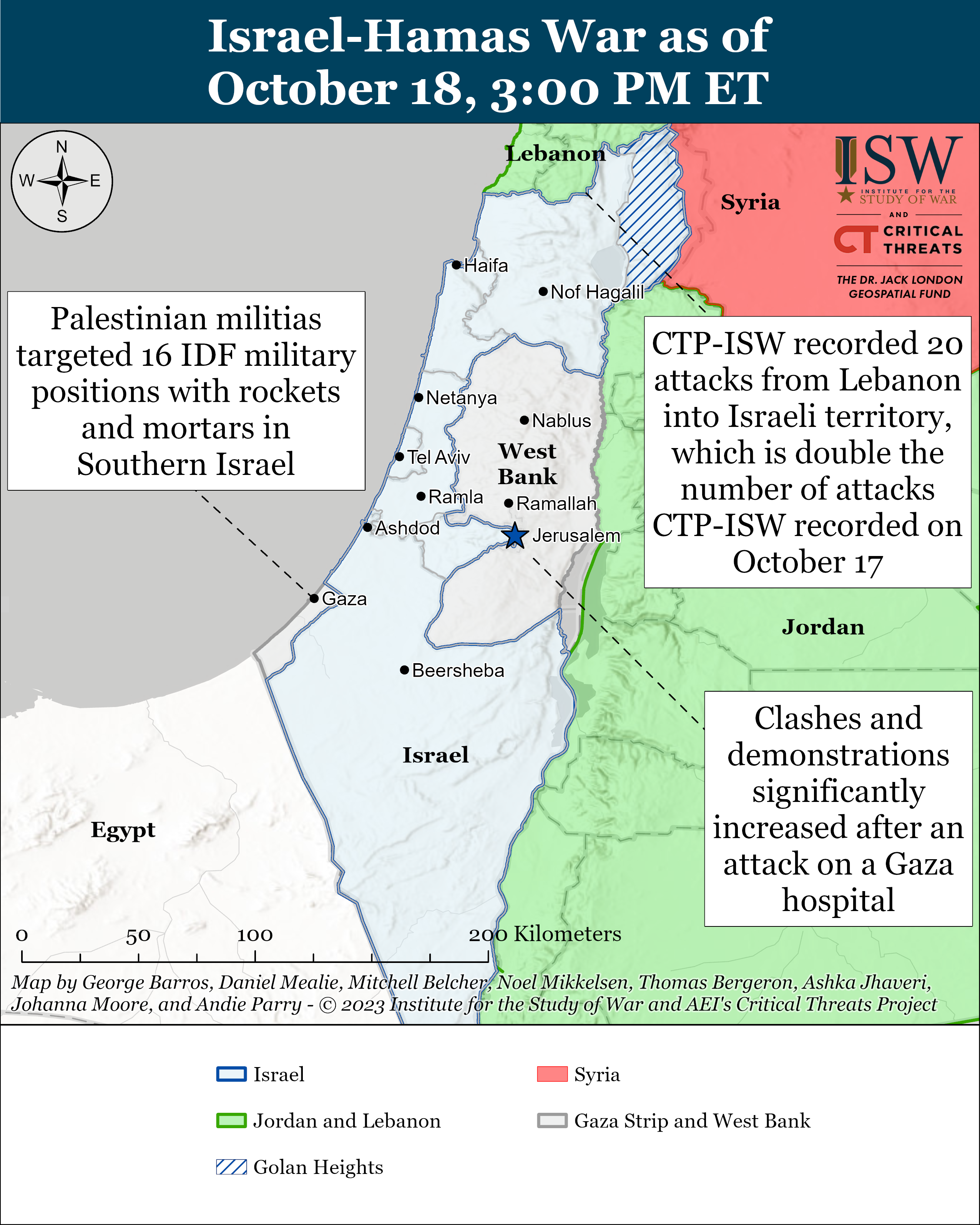
Key Takeaways:
- Palestinian militias continued indirect fire into Israel from the Gaza Strip. Palestinian militias targeted 21 IDF military positions with mortars and rockets in Southern Israel.
- The rate of clashes between Palestinian militants and Israeli forces in the West Bank expanded by 470 percent.
- CTP-ISW recorded 20 Attacks from Lebanon into Israeli territory, which is double the number of attacks recorded on October 17.
- Two Iranian-backed Iraqi militias conducted separate attacks on US forces stationed at the al Harir airbase and Ain al Asad airbase in Iraq.
- The Islamic Resistance in Iraq established the al Aqsa Joint Operations Room in support of Hamas' al Aqsa Flood operation.
- Iranian officials and media are blaming the United States and Israel for the explosion at the al Ahli hospital in the Gaza Strip and warning about the potential expansion of the conflict as a result.
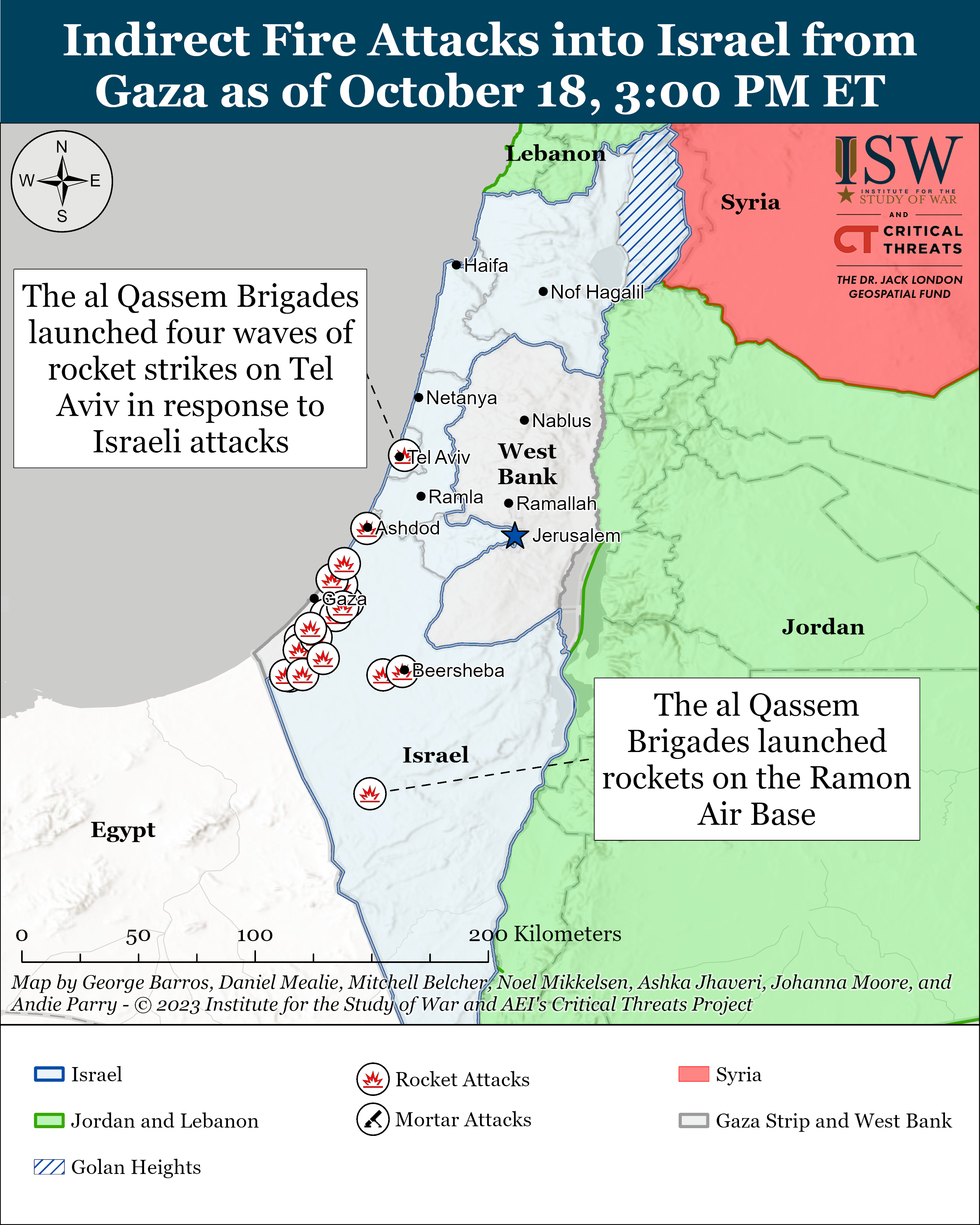
Recorded reports of rocket attacks; CTP-ISW cannot independently verify impact.
Palestinian militias continued indirect fire into Israel from the Gaza Strip on October 18. The al Qassem Brigades—Hamas’ militant wing—claimed responsibility for nine mortar and rocket attacks.[1] The al Qassem Brigades also launched four waves of rockets at Tel Aviv in response to Israeli “massacres against civilians.”[2] Saraya al Quds—the militant wing of Palestinian Islamic Jihad (PIJ)—claimed responsibility for another 16 rocket attacks.[3] The al Aqsa Martyrs Brigades—the militant wing of Fatah—claimed two rocket attacks into Israel from the Gaza Strip.[4] This rate of attacks is consistent with the rate that CTP-ISW observed in recent days.
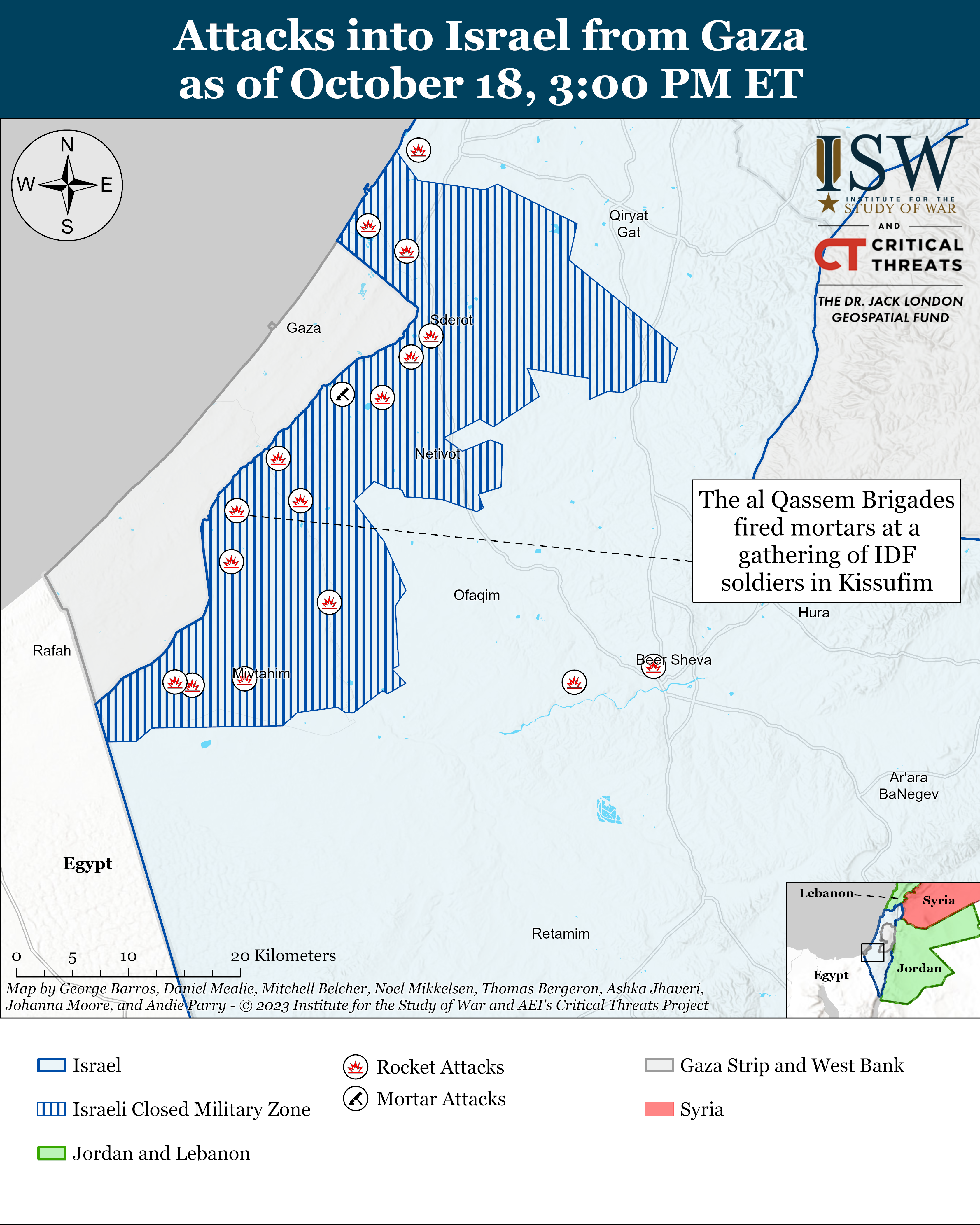
Recorded reports of rocket attacks; CTP-ISW cannot independently verify impact.
Palestinian militias targeted 21 IDF military positions with mortars and rockets in southern Israel. The IDF evacuated and designated the periphery of the Gaza Strip as a military zone on October 11.[5] ISW previously reported that the IDF deployed units to this area in recent days, which suggests that the militias seek to target IDF military assets in addition to civilian areas, such as Tel Aviv.
IDF airstrikes into the Gaza Strip continued to kill senior Hamas officials. The IDF reported that it killed the commander of Hamas’ anti-tank unit in the Gaza City Brigade, who was a prominent weapons dealer and coordinator for attacks.[6] The IDF also killed Hamas’ naval forces commander.[7]
West Bank
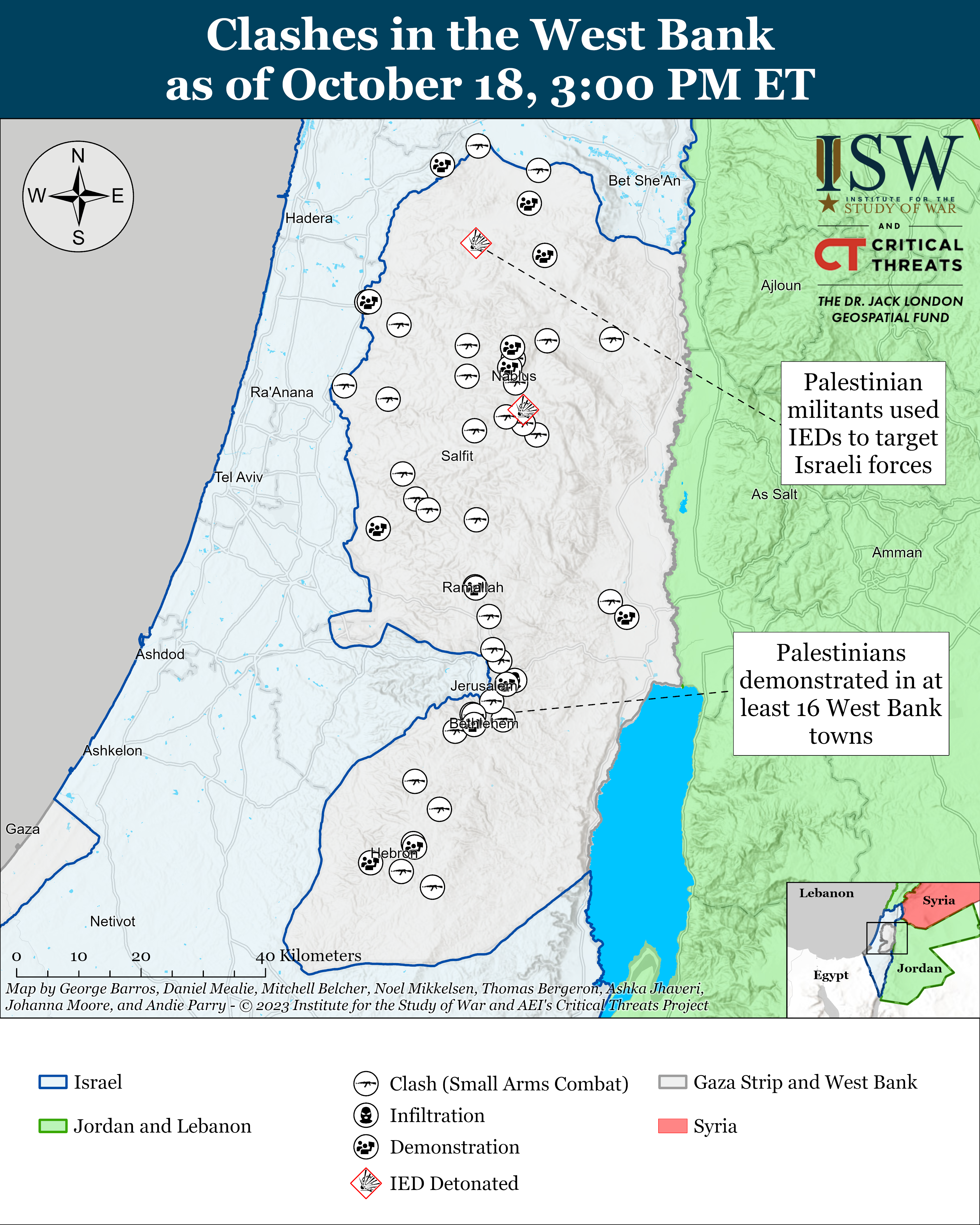
This map is not an exhaustive depiction of clashes and marches in the West Bank.
The rate of clashes between Palestinian militants and Israeli forces in the West Bank expanded by 470 percent on October 18.[8] CTP-ISW recorded 40 distinct clashes in the West Bank.[9] Clashes also expanded geographically to 37 cities and towns. Anti-Israel demonstrations within the West Bank tripled on October 18, compared to the previous two days.[10] Demonstrators mobilized rapidly after the Gaza hospital explosion on October 17. This is consistent with CTP-ISW's assessment that the rate of clashes would increase after the bombing.[11] Immediately after the explosion, Hamas called for clashes across Israel and the Palestinian territories.[12] Lebanese Hezbollah (LH) similarly called for a "day of unprecedented anger” in response to the hospital explosion and Biden’s visit to Israel.[13] Demonstrators in the West Bank likely responded to LH’s call as well as Hamas’.
Southern Lebanon and Golan Heights
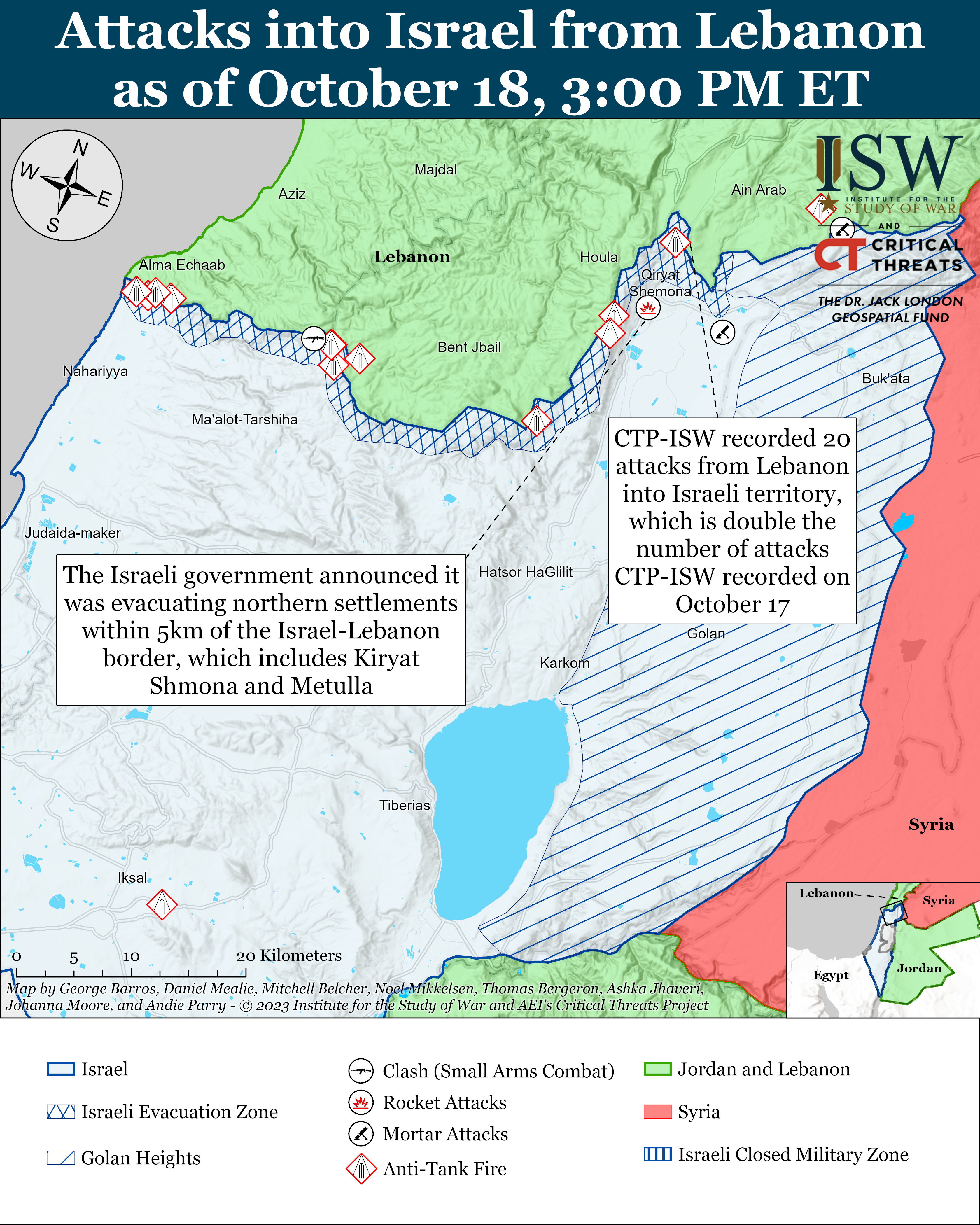
Recorded reports of rocket attacks; CTP-ISW cannot independently verify impact.
CTP-ISW recorded 20 Attacks from Lebanon into Israeli territory on October 18, which is double the number of attacks recorded on October 17.[14] The attacks targeted locations across the entire length of the Israel-Lebanon border. Fifteen of the attacks targeted military positions.[15] LH claimed responsibility for 15 attacks on military and civilian targets along the Israel-Lebanon border.[16] LH militants targeted Kiryat Shmona with nine rockets.[17] LH also launched an anti-tank guided missile (ATGM) at Metulla for the fourth consecutive day.[18] The Israeli government announced it was evacuating northern settlements within five kilometers of the Israel-Lebanon border on October 18, which includes Kiryat Shmona and Metulla.[19]
LH sources told a Lebanon-focused analyst on October 16 that Hezbollah recalled its cadres from abroad.[20] This is consistent with Syrian opposition media reporting since at least October 10, which claimed that LH redeployed forces from Syria to Lebanon.[21]
Palestinian militias remain active in southern Lebanon, likely with the approval of LH. The al Qassem Brigades said on October 18 that three of its militants died during an operation near Margoliot on October 14.[22] CTP-ISW previously assessed that LH probably approves attacks from southern Lebanon into Israel given the extent to which LH controls southern Lebanon.[23]
Syrian President Bashar al Assad blamed the United State and Israel for the Gaza hospital bombing on October 17 and called for three days of mourning.[24] CTP-ISW did not record any attacks related to the Israel-Hamas war into or from Syria on October 18, however. Over 1,000 Iraqi Popular Mobilization forces deployed to Homs Province from Iraq in the past several days, according to local opposition media.[25] The Islamic Revolutionary Guard Corps (IRGC) also transferred Iranian-backed militias from eastern Syria to southern Syria, the Golan Heights, and Lebanon from eastern Syria on October 16 and 17.[26]
Iran and Axis of Resistance
Two Iranian-backed Iraqi militias conducted separate attacks on US forces stationed at the al Harir airbase and Ain al Asad airbase in Iraq on October 18.[27] CTP-ISW previously reported that elements of Iran’s Axis of Resistance, including Iranian-backed Iraqi militias, have threatened to attack US forces if the United States intervenes in the Israel-Hamas war.[28] It is unclear if the two attacks were coordinated or if the IRGC Quds Force ordered the attacks.
- The Islamic Resistance of Iraq – an umbrella group of Iranian-backed Iraqi militias – claimed responsibility for targeting US forces stationed at the Ain al Assad airbase.[29] US Central Command (CENTCOM) reported that US forces engaged two drones, destroying one and damaging the other.[30] Two unidentified US officials reported that the two drones were one-way attack drones targeting the base.[31] Iranian-backed Iraqi militias last targeted the base in May 2022.[32]Tashkil al Waritheen—an Iranian-backed militia—claimed responsibility for conducting a drone attack targeting US forces stationed at the al Harir airbase in Iraqi Kurdistan.[33] Waritheen claimed responsibility on behalf of the al Aqsa Joint Operations Room. Iraqi Kurdistan-based Shafaq News cited an unidentified Iraqi source, who claimed that it was unclear what damage, if any, the drone had done on the base.[34] Tashkil al Waritheen reports directly to Iran’s IRGC Quds Force.[35] CENTCOM reported that US forces stationed al Harir airbase destroyed the drone targeting the airbase.[36]
Iranian officials and media are blaming the United States and Israel for the October 17 explosion at the al Ahli hospital in the Gaza Strip and warning about the potential expansion of the conflict as a result. President Ebrahim Raisi claimed that “US-Israeli bombs” were dropped on the hospital on social media on October 18, echoing claims from Iranian officials and media since October 13 that the United States is playing a direct role in the Hamas-Israel war.[41] Foreign Affairs Minister Hossein Amir Abdollahian claimed that US Secretary of State Antony Blinken was present in the Israeli operations room during a meeting with his Qatari counterpart Sultan bin Saad al Muraikhi in Jeddah on October 18.[42] IRGC-affiliated Tasnim News Agency claimed that the United States had devised the Israeli attack to disincentivize an Israeli ground operation into Gaza.[43] Several Iranian regime outlets claimed either that American munitions were used in or that the United States had authorized the strike on the hospital.[44] These same outlets claimed that Iranian protesters were holding the United States responsible for the specific attack and greater Israeli “crimes” in Gaza on October 18.[45]
- President Ebrahim Raisi stated that Israel’s “criminal, crazy, and illegal actions” will expand the war to the region during a meeting with Brazilian President Luiz Inacio Lula da Silva on October 17.[46] The Raisi administration similarly issued a statement on October 18 warning that the hospital bombing “will not go unanswered.”[47] The Artesh—Iran's conventional military—also published a statement on October 18 condemning Israel for allegedly attacking the al Ahli hospital and warning that the Artesh is looking to respond “forcefully” to the attack and bring the “criminals” to trial.[48]Expediency Discernment Council member and former IRGC Commander Major General Mohsen Rezaei warned on October 18 that a “big storm” is coming and pointed to the potential for the formation of new Islamic militant groups seeking to enter the conflict with Israel.[49] Parliament Speaker Mohammad Bagher Ghalibaf similarly warned that Israel is “opening up the gates of hell with their own hands and are filling all Muslims with wrath,” further arguing that Muslims are ready to make sacrifices to confront Israel.[50]Armed Forces General Staff Chief Major General Mohammad Bagheri echoed Supreme Leader Ali Khamenei’s October 17 remarks that “the resistance” will lose its patience were Israel to continue its “war crimes” within a statement condemning the alleged attack on the al Ahli hospital on October 18.[51] IRGC-affiliated Fars News Agency published an article warning that “the resistance” will deliver an “even harder slap” against the Israeli regime while pointing to the “activation” of LH on the northern front.[52] “The resistance” is the term that Iranian officials and media use to describe the proxy and partner militias that Iran sponsors throughout the Middle East.
Palestinian militias are using the October 17 explosion on the al Ahli hospital in the Gaza Strip to frame the United States as a belligerent in the Israel-Hamas war. The IDF said that PIJ conducted a rocket attack that failed and hit the active hospital. The IDF spokesman noted that 450 rockets from the Gaza Strip have failed and fallen short since October 7.[57] The Hamas-run Health Ministry contrastingly and falsely claimed that an Israeli airstrike hit the hospital and that hundreds of people died. A senior adviser to Israeli Prime Minister Benjamin Netanyahu accused Hamas of inflating civilian casualty numbers.[58]
- The IDF released an audio recording of two Hamas militants discussing how PIJ fired the rocket and noted that the rocket at the impact site was locally made. Independent analysts on Twitter and Bellingcat noted that images of the aftermath of the attack are inconsistent with reports of missiles or joint direct attack munitions (JDAMs).[59]A Twitter user posted on October 17 that “"The Wall Street Journal: 'The bomb that was dropped on the hospital was an American MK-84” and that "this bomb is precision-guided, largest in MK family, and has about 950 kg weight."[60] Newsweek confirmed that the claim is false.[61] US President Joe Biden said the data that the Department of Defense showed him says Israel was not to blame for the attack.[62]The PIJ spokesman echoed Iranian rhetoric that the bombs used to strike the Gaza hospital were American bombs.[63] Hamas released a statement that the US adoption of the Israeli narrative that PIJ misfired a rocket is considered participation in the attack.[64] Hamas also stated its appreciation to cancel the US-Jordan-Palestinian Authority-Egypt summit scheduled for October 18.[65]
Kataib Hezbollah-affiliated Tura News circulated calls to protests in solidarity with Palestinians at the US Embassy in Baghdad on October 18.[68] Ashab al Kahf called for Iraqis, “youth of the popular mobilization,” and other supporters to demonstrate in Tahrir Square, Baghdad on October 17 following the explosion the al Ahli Hospital. Protesters gathered in Tahrir Square and attempted to approach the US embassy but were blocked by Iraqi security forces.[69]
Iranian regime outlets and officials are attempting to generate further momentum for the current Israel-Hamas war. Iranian media circulated disturbing images of severely wounded or killed Palestinian children on October 18.[70] IRGC-affiliated media published a series of responses to Israel’s “infanticide” in Gaza and recirculated calls for the expansion of ”anti-Zionist” demonstrations in the West Bank.[71] Several Iranian officials and outlets claimed that millions of ordinary Iranians are prepared to volunteer in the fight against the Israeli regime.[72]
Violent protests occurred at US positions in the Middle East following LH calls for a “day of rage” in solidarity with the Gaza Strip. Hundreds of protesters demonstrated outside of the US Embassy in Beirut and attempted to remove barbed wire and barricades.[73] Some people burned a building near the embassy.[74] The embassy issued a travel advisory not to travel to Lebanon and recommended that US citizens leave the country.[75] Protesters attempted to storm a US base in Turkey, according to a pro-Axis of Resistance telegram.[76]
No comments:
Post a Comment